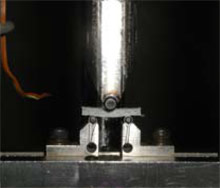A Cheaper Way to Draw Oil from Shale
A new ceramic-composite material that can withstand high temperatures and constant exposure to moisture could provide an economical way to unlock America’s vast oil-shale deposits.

U.S. oil-shale resources hold three times as much crude oil as the whole of Saudi Arabia. But unlike with the gushing fields of the Middle East, extracting oil from shale is like trying to squeeze juice out of frozen lemons. Traditionally, the shale has been surface mined like coal and heated until an oil-like substance called kerogen turns to liquid and oozes out. But this is an expensive, energy-hungry, and carbon-intensive approach that, like much of the extraction happening in Canada’s controversial oil sands, is also devastating to the local environment.
More recently, companies such as Royal Dutch Shell have developed ways to tap the oil in situ, by drilling boreholes that are thousands of feet deep and feeding into them inch-thick cables that are heated using electrical resistance and that literally cook the surrounding rock. The kerogen liquefies and gradually pools around an extraction well, where the oil-like fluid can easily be pumped to the surface.
The process involves no mining, uses less water than other approaches, and doesn’t leave behind man-made mountains of kerogen-sapped shale. And according to a Rand Corporation study, it can also be done at a third of the cost of mining and surface processing. One technical hitch, however, lies with the heater cable employed. The most common cables used today are insulated with a layer of magnesium oxide, which can deform, degrade, and ultimately short out over time under intense heat, constant exposure to moisture, and the occasional shifting of rock at great depths. Replacement and maintenance can be costly.
Handling such extremes requires “a combination of properties not currently available on the market,” says Joe Culver, an official with the Department of Energy (DOE), which considers oil shale vital to America’s energy security. In Colorado, Wyoming, and Utah alone, deposits equate to more than 800 billion barrels of recoverable crude.
Composite Technology Development of Lafayette, CO, set out to tackle the cable insulation challenge using a woven ceramic-fiber tape that gets wrapped around copper wiring. The ceramic insulation is a composite material that consists of ceramic fibers and an inorganic ceramic matrix that binds the fibers together. “It’s our secret sauce,” says executive vice president Mike Tupper, explaining that the fibers can also come braided or in the form of cloth, depending on the application.
The wrapped wire is heated to 150 °C until a resin in the tape hardens the insulation, but the insulation remains flexible for shipping and installation. It’s then heated on site to 500 °C, turning it into a solid, durable ceramic coating.
As part of a recent demonstration project under a DOE program, Composite Technology successfully tested its insulated cables for more than 5,000 hours at temperatures ranging from 760 to 850 °C. At these high temperatures, “it has stable electrical properties,” says Tupper. “It’s not affected by the environment, and it doesn’t degrade.”
Tupper adds that the cables can also operate under a wide range of voltages and temperatures, and can be manufactured in virtually any length. “There are similar types of materials out there, but we’ve developed a way to make something that would perform the same way but at a fraction of the cost,” Tupper says. “That makes the economics work for the oil and gas industry.” He adds that Shell has already evaluated the technology and is showing strong interest.
But even with this breakthrough, some question the wisdom of using electricity to heat up rock just to squeeze more oil out of the planet. Shell claims that its process produces three to seven units of energy for every one unit that’s needed for the process.
“Assuming this cable worked, what does that give you?” asks Clement Bowman, a former top scientist at Imperial Oil, who helped lead the development of Canada’s oil sands. “Electricity is a high-end electrical product, and using it to recover low-end energy products like kerogen or bitumen will always carry an economic penalty.”
Keep Reading
Most Popular
Large language models can do jaw-dropping things. But nobody knows exactly why.
And that's a problem. Figuring it out is one of the biggest scientific puzzles of our time and a crucial step towards controlling more powerful future models.
The problem with plug-in hybrids? Their drivers.
Plug-in hybrids are often sold as a transition to EVs, but new data from Europe shows we’re still underestimating the emissions they produce.
Google DeepMind’s new generative model makes Super Mario–like games from scratch
Genie learns how to control games by watching hours and hours of video. It could help train next-gen robots too.
How scientists traced a mysterious covid case back to six toilets
When wastewater surveillance turns into a hunt for a single infected individual, the ethics get tricky.
Stay connected
Get the latest updates from
MIT Technology Review
Discover special offers, top stories, upcoming events, and more.